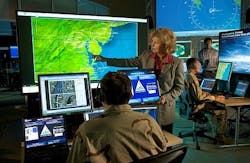Military intelligence research seeks to uncover threats from social media, other text
ROME, N.Y., 20 Aug. 2015. U.S. Air Force military intelligence experts are asking industry for new ways of uncovering existing and future global military threats from mountains of openly available text data, such as social media, blogs, and chat rooms.
Officials of the Air Force Research Laboratory Information Directorate in Rome, N.Y., issued a solicitation Tuesday (BAA-AFRL-RIK-2015-0019) for the Multi-Source Information Extraction & Network Analysis (MUSIENA) program.
MUSIENA seeks to develop analytics, analytical tools, algorithms, and projects to help Air Force and other intelligence analysts sift vast amounts of text data quickly to discover and identify global military threats, as well as analyze emerging global threats.
Although previous research has led to automated tools to extract information from large volumes of textual data, it has not kept pace with the sheer volume of data that analysts must investigate. MUSIENA seeks to move beyond current capabilities and move to new data types and domains.
Related: Siemens, Carnegie Mellon, and HRL pursue artificial intelligence to analyze images and text
The global threat discovery and identification (GTD-ID) portion of the MUSIENA program will deliver rapidly customizable, learning-based text extraction to provide deeper understanding of the information that can be pulled from multi-source unstructured text.
Toward this goal, domain customization, complex event extraction, and text exploitation platform for multi-source analysis will be key enabling technologies for affordable, easy-to-use, accurate text-exploitation.
Emerging threat analytics, or ETA, will address multi-source fusion and social media exploitation for threat assessment, explanation, and anticipation. The program also seeks to tackle some of the challenges of gathering useful information from billions of social media posts generated by millions of users.
The goal is to develop automated tools to enable analysts to investigate individuals, uncover relationships, and follow connections to reveal networks of people and organizations, as well as decipher unfolding events and predict future events.
Related: DARPA launches DEFT program to pull actionable intelligence out of ambiguously worded text
Funding available to the MUSIENA program is about $10 million over the next three years, and several contractors may be involved. The Air Force only wants white papers now, not formal proposals. Companies interested should email white papers no later than 18 Sept. 2015 to the Air Force's Edward DePalma at [email protected].
Email technical questions or concerns to Edward DePalma at [email protected], and contracting questions to Gail Marsh at [email protected].
More information is online at https://www.fbo.gov/spg/USAF/AFMC/AFRLRRS/BAA-AFRL-RIK-2015-0019/listing.html.

